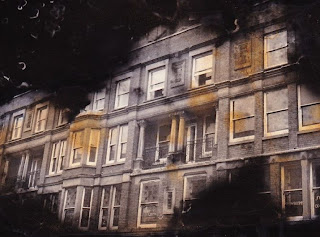The title of the brief was 'Personal Project' . I was required to go above and beyond the techniques and experiments I already knew to find
and do a wider range of experiments that I have never tried before. It gave me the opportunity to show my technical abilities through a range of digital and darkroom experimentation. At the end of the project I would have a sketchbook showing a working progress, mounted sheets of my best work, and a final outcome. The theme that I chose to run through both coursework projects was architecture.
This project developed quickly for me as I enjoyed working with my chosen theme. Firstly I explored a range of different artists and photographers that I liked the work of. This lead me to in-depth analysis of a selection of artists who's work had inspired me the most. I created my own experiments based on their work. I used digital and film photographs to experiment with through Photoshop and in the darkroom. I had revisited previous experiments from that last projects that I had liked as I thought they would work well with my chosen theme. Using my imagination I combined these different experiments and techniques to come up with new imaginative ideas. Using both my own ideas and the inspiration from the works of other artists it helped me improve and enhance my images.
The first film that I took was of buildings in and around my area, when I was taking the photographs I had ideas in my head of ways that I could experiment with them. For example I wanted to experiment with taking photographs of windows,doors, sides of buildings to put together to make one building. When I was shooting my film I considered which parts of a building I would need to take for this to work. However as I only allowed 4 photographs per experiment this did not leave me with enough photographs for this idea to work fully. I did not take this idea any further than just an idea but hopefully in future projects I might be able to experiment with this idea.
The photographer that inspired me for my final outcome was Chris Seddon. He photographed a project called 'mapping Nottinghamshire'. It involved people from the local area to go out and take photographs on their phone or camera then to go to Rufford Gallery to print out the photograph onto a luggage label then pin it onto a map of Nottinghamshire where the photograph was taken. I really liked this idea as it is an original way of presenting photographs that I had never considered before. I thought it worked really well with my chosen theme of architecture.
Experiments such as the handmade negatives and staining my photographs I think worked particularly well. To create the handmade negatives I got a small piece of clear plastic then I applied salt, washing up liquid and food dye. I then placed this in the negative carrier. This created a really cool effect which I thought would look amazing if I could apply it on top of my photographs. I experimented with different ways of combining a print with the handmade negative. I found that the best way was to expose the handmade negative to the paper then taking away that exposure time from the expose time I would use for the print, I then exposed the print onto the same piece of paper then developed it. This worked really well and had a great outcome, the image looked as if it had been destroyed. I took this even further by applying a wash of coffee to the print to give it an aged look as I the photographs were of old buildings it would in-keep with the idea of being old and aged. I took this forward into my final piece and pinned these experiments onto the map.


I am really pleased with my outcome as my ideas developed from a simple idea to a complex one. My final idea involved me printing in the darkroom a variation of different sized images onto photographic paper. I then scanned these onto different types of paper and stained some with coffee to give them an aged effect. I pinned them to the map using a variation of different pins and string. I think this added to the authenticity of it and gave it an overall quirky look. I decided not to use luggage labels for my final outcome as I think they worked better on a map with less photographs as it did not become confusing and over worked.
I think I could have improved on the final outcome by using a wider range of photographs. As I had only shot two films it didn't give me many photographs to work with as not every photograph came out well. In my final outcome on the back of some of the photographs I stamped the time that I took the photographs. I think I could improve on this by being more adventurous with this idea by maybe stamping the street name or a bit of information about the place the photograph was taken.






























